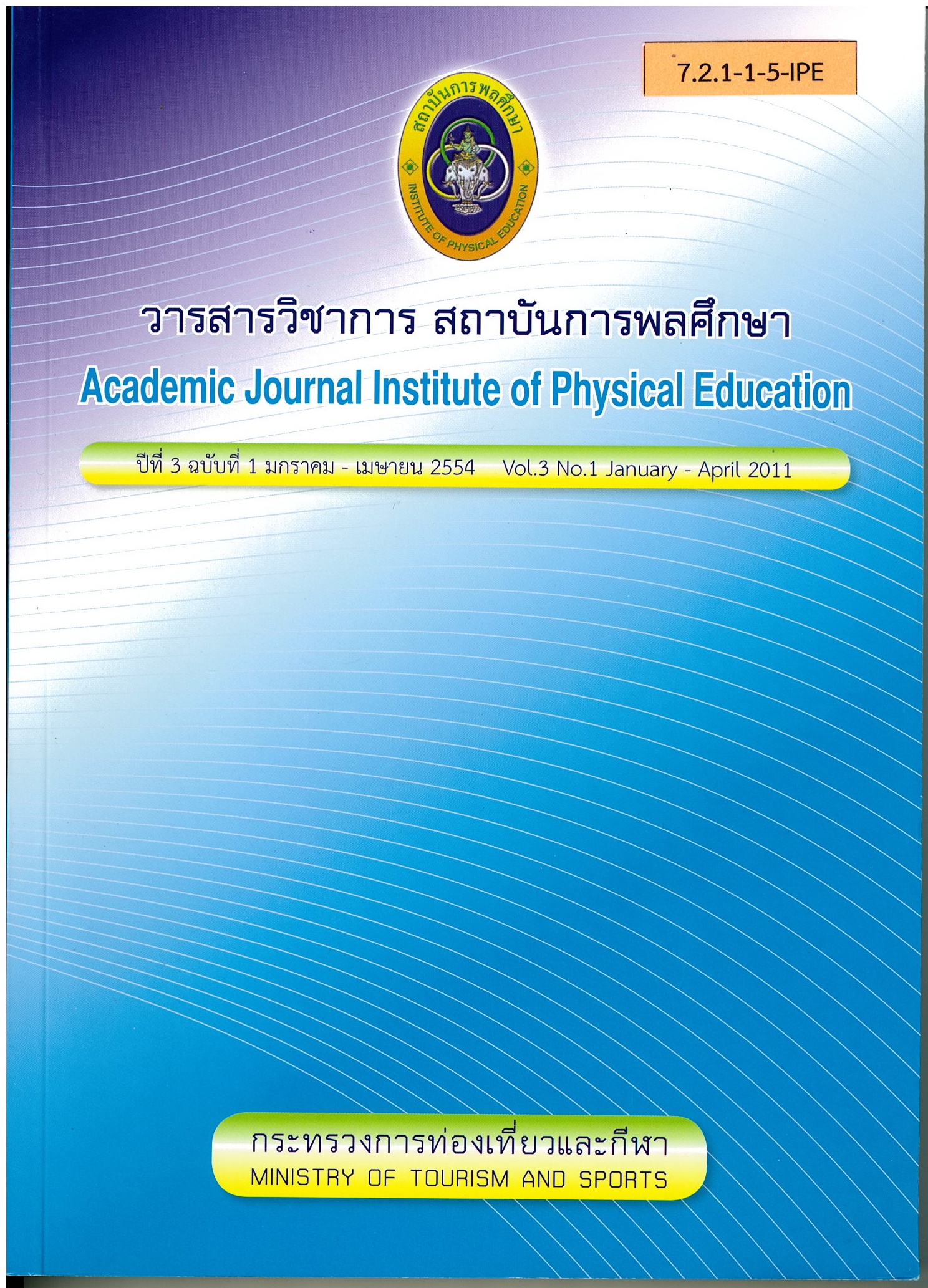Effects of Body Weight and Elastic Trainings on Muscular Leg Strength in the Elderly
Main Article Content
Abstract
The purpose of this study was to determine the effects of body weight and elastic trainings on muscular leg strength in the elderly. Subjects were Elderly from Baanbangkae. who had never heart disease, diabetes and osteoarthritis, First, thirty people were purposive sampling. Second, they were measured the leg strength (pre - test). Finally, 30 Subject were selected based on their pre - test scores. These subject were divided equally into tree groups, ten each group. A control group did not receive treatment, The experimental group I practiced body weight and group ll practiced elastic training, tree times a week for eight weeks. The muscular leg strength in the elderly were measured prior to training and after the 4th, and 8th week of training. Rusults were found as follow.
- Muscular Leg strength, experimental group and body weight group, before training, after 4th weeks of training and after 8th weeks of training were significant differences at .05 level.
- Muscular Leg strength, experimental group and elastic group, before training, after 4th weeks of training and after 8th weeks of training were significant differences at .05 level.
- Muscular Leg strength, experimental group and control group, before training, after 4th weeks of training and after 8th weeks of training were not significant differences. 4. Muscular Leg strength, experimental group body weight, elastic group and
- ps before training not significant differences after 4th weeks of training leg strength, experimental group body weight not significant differences from those experimental elastic group but experimental group body weight and elastic group were significant differences from those experimental control group were significant differences at .05 level. After 8th weeks of training experimental group body weight, experimental elastic group and control group were significant differences at .05 level.
Article Details
The published article is a copyright of the Academic Journal of Thailand National Sports University. The passage appeared in each article in this academic journal is a perspective of each author which is not related to the journal. Each author is required to be responsible for all components of his/her own article. If there are any mistakes, each author must be responsible for those mistakes on his/her own.
References
กัญกมล บัวแก้ว. (2549). การศึกษาครั้งนี้ทําการศึกษาผลการฝึกด้วยยางยืดและผลการฝึกด้วยน้ําหนักที่มีต่อความแข็งแรงกล้ามเนื้อ. ปริญญานิพนธ์ วท.ม. (วิทยาศาสตร์ การกีฬา), กรุงเทพฯ: บัณฑิตวิทยาลัย มหาวิทยาลัยศรีนครินทรวิโรฒ.
เจริญ กระบวนรัตน์. (2540). ยางยืดพิชิตโรค. กรุงเทพ: บริษัทแกรนสปอร์ต กรุ๊ป จํากัด.
เจริญ กระบวนรัตน์. (2548). การฝึกความแข็งแรงกล้ามเนื้อ กรุงเทพฯ มหาวิทยาลัยเกษตรศาสตร์.
นิตยา สุภาวนันท์. (2541). การศึกษาสภาพแวดล้อมที่เสี่ยงต่อการเกิดอุบัติเหตุหกล้มของผู้สูงอายุ. วารสารพยาบาลศาสตร์.
บรรลุ ศิริพานิช. (2541). หลักการออกกําลังกายเพื่อสุขภาพสําหรับผู้สูงอายุ. พิมพ์ครั้งที่ 2. กรุงเทพฯ: หมอชาวบ้าน.
ศิริรัตน์ หิรัญรัตน์. (2535), การฝึกความสมบูรณ์ทางกาย กีฬาเวชศาสตร์พื้นฐาน. กรุงเทพฯ: มหาวิทยาลัยมหิดล.
สนธยา สีละมาด. (2547). หลักการฝึกกีฬาสําหรับผู้ฝึกสอนกีฬา กรุงเทพฯ: สํานักพิมพ์จุฬาลงกรณ์มหาวิทยาลัย.
สิทธิชัย จิตพันธ์กุล. (2542). หลักสําคัญของเวชศาสตร์ผู้สู้สูงอายุ กรุงเทพฯ: จุฬาลงกรณ์มหาวิทยาลัย.
Amheim, Daniel D. & Prentice, William E. (1993). 8 th ed. Principle of Athletic Training. United States of America.
Ballard; et al. (2004). The effect of 15 of exercise on balance, Leg Strength and Redaction in Falls in 40 women aged 65 to 89 year. (online). Available: http://www.ncbi.nlm.nih.gov/enterz/query.fcgi?MD=Disply&DB=Pubmed
Higbie, Elizabeth Johnson. (1995). "Effects of Concentric and Eccentric Isokinetic Heavy-Resistance Training on Quadriceps Muscle Strength; Cross-Sectional area and Neural Activation in Woman (Muscle hypertrophy, magnetic resonance imaging). University of Georgia. Dissertation Abstracts International. 29 (2): 162A.
Joseph B Myers.; et al.(2005). “On-the-Field Resistance-Tubing Exercises for Throwers: An Electromyographic Analysis.” Retrieved October 12, 2005, from http:// www.pubmedcentral.nih.gov/articlerender.fcgi?artid=1088340&rendertype=abstract.

